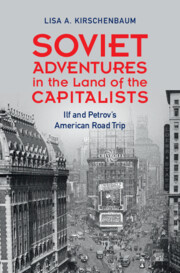Book contents
- Soviet Adventures in the Land of the Capitalists
- Soviet Adventures in the Land of the Capitalists
- Copyright page
- Dedication
- Contents
- Figures
- Acknowledgments
- Note on Transliteration and Translation
- Abbreviations
- Introduction
- Part I Promised Lands
- Part II New York and the Eastern States
- Part III To the Pacific Ocean
- Part IV The Golden State
- Part V Journey’s End
- Select Bibliography
- Index
Introduction
Published online by Cambridge University Press: 18 January 2024
- Soviet Adventures in the Land of the Capitalists
- Soviet Adventures in the Land of the Capitalists
- Copyright page
- Dedication
- Contents
- Figures
- Acknowledgments
- Note on Transliteration and Translation
- Abbreviations
- Introduction
- Part I Promised Lands
- Part II New York and the Eastern States
- Part III To the Pacific Ocean
- Part IV The Golden State
- Part V Journey’s End
- Select Bibliography
- Index
Summary
The introduction argues that Soviet satirists Ilf and Petrov’s 1935 American road trip offers a fruitful and innovative means of identifying the mediators who engaged in building friendly Soviet–American relations. Such means are necessary because unlike the Soviet state, the American government in the 1930s did not guide or systematically track Soviet visitors. Providing a brief overview of Ilf and Petrov’s biographies, the introduction highlights the mixture of fact and fiction in their American travelogue. It concludes with a sketch of their American itinerary and the wide range of sources employed to reconstruct their contacts with Americans.
- Type
- Chapter
- Information
- Soviet Adventures in the Land of the CapitalistsIlf and Petrov's American Road Trip, pp. 1 - 14Publisher: Cambridge University PressPrint publication year: 2024

